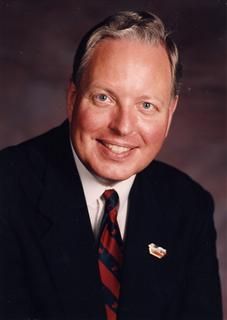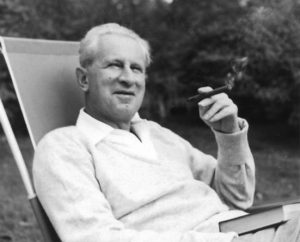The Knife Edge
I have been following several hikers on the Appalachian Trail through their daily video blogs. The objective of many those hikers traveling northbound on the trail is to start here in Georgia and hike to the summit of Mt. Katahdin in Maine. That is the end of the trail for most. They go back and retrace their steps down the trail to the bottom and go home.
One such hiker I have been following actually started in Key West with the objective to hike all the through trails on the East Coast including those in Florida, Alabama, Canada and the Appalachian Trail. He finished Katahdin with some ease but his ultimate goal was Canada, so rather than retrace his steps he took a different descending trail to the East toward Canada called the Knife Edge Trail. For him, it was a shortcut to his goal. This trail proceeds down a narrow crest of broken rock which falls off precipitously in either direction to near-certain death. Parts of it are rated as Level III mountain climbing described as “There are high risks of falling and a high chance of injury. Falls can be fatal.” It is not for the faint of heart. Since 1926 over 44 people have fallen toward one side or the other to their deaths. Many more were seriously injured.
So, I lie in bed having nightmares about hiking the Katahdin Knife Edge Trail. But they alternate with nightmares about the transgender position on the knife edge between radical right and left politics. It is even scarier that I am going to write about the political nightmares herein but I need to get it out of my system.
I will start with a little history about the radical right and left and then provide some suggestions on how to cope with them.
The Enlightenment and Radical Rejection
The Enlightenment was a period in the 1600s in which Western Culture discovered and adopted a philosophy that has resulted in great prosperity and benefits to most everyone in societies that followed it. The Enlightenment adopted a Modernist philosophy of rationality, reason and objectivity. It formed the basis for science and engineering, free inquiry and debate, individual agency, modern democracy, modern medicine and delivery of material goods. Admittedly, it has been a constant struggle to realize its goals, that of progress and happiness for all; we are still working at it.
Both the current radical right and radical left reject the Enlightenment philosophy. The radical right and left both share these characteristics:
- Collectivist/Anti-individualist
- Authoritarian
- Anti-medicine
- Anti-science
- Anti-democratic
- Anti-capitalist
Trans people, along with others in society, have greatly benefited from Modernist Enlightenment philosophy. The threats posed by right and left may prevent continuation of these gains. Trans people are individualistic and pride themselves on being free to follow their own gender behavior category or even no behavior category at all. They arrived at being transgender by their own experimentation and inquiry as to what path they should follow in terms of gender behaviors. Transgender people generally rebel at authoritarian governments and people telling them what to do and how to behave. As long as it does not hurt anyone they we want to be free to behave as we wish. We have greatly benefited from modern medicine and science which emerged in the latter half of the 19th Century. It makes possible modifications to our bodies to align our sex with our congruent gender, if we so choose. Hormones, as medicines were isolated, synthesized and available in the 1930s as a result of the establishment of modern medicine. We take pride as individuals to participate in political activity and voting as a fair way to make societal decisions, even though there are sometimes barriers to our participation. Finally, we live in an unprecedented time of economic abundance which allows us to pursue our own individual goals and provide charity for those less fortunate. Countries that reject Modernism and do not appreciate the benefits of a free economic system have not done so well. We have given our government the responsibility to set the rules of capitalist competition to avoid over–concentration of economic power and hold our leaders to enforce those rules .
Premodernism, Modernism and Postmodernism
“Premodern” philosophy ruled for about 1300 years in the West before the Enlightenment. In Premodernism, the Church was the authoritative source to tell people what to do. They threatened people with both earthly and ethereal penalties for misbehavior. Religion was used to justify numerous wars and atrocities that killed millions of people and cause untold misery. And then there was the Inquisition. Because religion can be seen as a reflection of current culture, it became a cover story for collectivist nationalism in 1930s Germany as the Nazis took power. But Premodernist philosophy continues among some today, due to the freedom of thought that Modernism provides. As we shall see, evangelical Christianity in the U.S. has been radicalized and now poses a threat to transgender people by advocating the curtailment of our rights (e.g. voter ID laws which inhibit transgender voting), limiting our visibility (e.g. bathroom bills), and governing our behavior (e.g. preventing access to Modern medicine).
Eventually, some bright theologians in the 1400-1600s concluded through rational thought that people could have direct connections to God as individuals. The sovereignty and agency of individuals soon followed in non-church domains which laid the path open for the “Modernist Enlightenment” in science, medicine, democracy, capitalism and other realms.
Political Postmodernism evolved from Marxism in the 1950s and further evolved into the current radical left. The essence of postmodernism is that nothing is real and therefore Postmodernists can advocate without regard for reason and facts for collectivism, authoritarianism and anti-science, anti-democracy and anti-capitalism. Although history reveals that Marxism and its collectivist branches resulted in mass murder in the 20th Century, the Postmodernists prefer to erase those details of reality and reason.
A good comparison of Premodernism, Modernism and Postmodernism is provided by Steven Hicks in this book Explaining Postmodernism. This book is presented by Hicks as an audiobook on YouTube and also in a video lecture here.
The Radical Right
The current radical right is a mainly the result of the efforts of Paul Weyrich during the 1970s and 1980s who sought to enlarge the GOP constituency with the help of Laszlo Pasztor, a Nazi Hungarian collectivist. One could consider Nazism as a radical form of Premodern national collectivism but it was also influenced by developments on the left, notably the Leninist communist revolution in Russia. For example, Hilter retained and concentrated economic power through an oligarchy of companies and people which Lenin had done when he found that pure Communism was impractical.
Weyrich pursued evangelical Christian support, mainly in the South, with the promise that the GOP would revenge the taxation of segregated Christian schools. Such schools had been set up to dodge the precedent of Brown v. Board of Education in 1955 but during the Carter administration they lost their tax exempt status. They wanted to fight back against the Federal government but in order to avoid accusations of racism, they pursued other cultural war issues instead. These included prohibiting abortions and preventing LGBT people from exercising their rights, both of which their theology could consider sinful if culture demanded it. This movement dovetailed with the interests of the leaders of some Southern states who wanted to keep the Feds out of their business because it was infiltrated by economic and crime oligarchies. You can read about this history in Randall Balmer’s book Bad Faith. He is a religion professor at Dartmouth College and he has first-hand knowledge from his family’s participation in Weyrich’s activities in the 1970 and 1980s.
Since that era, the radical right has called for and sanctioned violence toward the overthrow of the U.S. government. The recent violence of 1/6 illustrates that they intend to tear down society by force, if necessary, in order to gain political power.
The Radical Left
The intellectual history of the current radical left begins in in Germany with Karl Marx in the 1850s with collectivist philosophies originally intended to improve societies. These philosophies
ultimately became misused for authoritarian takeovers of Russia and several Eastern European countries early in the 20th Century.
Marxism had to evolve because it was failing. After World War I, German Communists expected communist revolutions in Western European countries to the overthrow governments by working class people but these revolutions did not succeed. Russia was taken over, using a Communist cover story, by Lenin. Lenin eventually moved away from pure Communism towards capitalism in order to improve his government–run economy and set up an oligopoly with a limited number of firms that he could control. Hitler in Germany was on the far right not the left. But also rejecting the Enlightenment, he learned from Lenin’s economic model. (It should be noted that Putin’s current economy model is just a weak version of the oligopolies of Lenin and Hitler.)
The German and other Communists were frustrated by the lack of Communist takeovers in Europe after World War I and the failure of pure Marxism. So, they set up a center at Frankfurt University, later called the “Frankfurt School.” to try to understand these failures and adjust Marxism. They were going to call it the “Institute for Marxist Studies” but instead settled on the lower profile “Institute for Social Research.” (Leftist terminology legerdemain has continued to this day.) They concluded that it was the cohesive cultures of European countries that prevented revolution from being successful. Their solution was called “Critical Theory”. One is tempted to ask what is the theory— but the answer is that there is none. The concept of critical theory just means to be critical of every available fault in a culture in order to tear down societies by disrupting culture.
When Hitler decided to eliminate his Communist rivals, the Frankfurt School temporarily moved to Columbia University in New York City. After World War II, with no Communist revolutions in Western Europe or the U.S. and the admissions of the atrocities of Stalin in Russia against his own people, some French/U.S. Communists again were in a quandary. Takeovers by the radical left had resulted in the deaths of hundreds of millions of people (not just from war but also from political purges that killed people within these countries). I spent several years in Ukraine and the discussion still echoed about the 10 million or so Ukrainians that Stalin had starved to death.
Rather than being objective about the faults of Communists, they decided to continue their beliefs by changing to a subjective philosophy. This was the birth of political Postmodernism. Postmodernism supports the idea that cultural groups can make up any beliefs regardless of objective fact including those continuing beliefs in Marxism.
Although most of the French political Postmodernists returned to Germany after WWII, one member of the Frankfurt School remained in the U.S.–Herbert Marcuse. He was very influential in academic circles and found that students and academic were lucrative targets. He and others contributed to the student uprisings in the 1960s and sanctioned free-love through their philosophical writings. The venom of political Postmodernism became widespread in academia. Marcuse developed the concept of “liberating tolerance” which means that they will not allow people in opposition to their views to speak or write. This was the start of de-platforming which we see today. I was a spectator on Postmodern activities in college and graduate school, never believing that such thinking would permeate academia. It has now spread outside the academy into journalism, companies and institutes. And, like the right, it has sanctioned violence. You can read the details about the development of these ideas in a book by Helen Pluckrose and James Lindsay entitled Cynical Theories.
The Postmodernists have tried to adopt transgender and gay issues in their struggle for power. As part of their relentless criticism they formed Critical Queer Theory. This branch of Critical Theory tries to treat transgender and gay people, not as individuals, but as interest groups to be manipulated and used as “poster children” and “tokens” to criticize culture. Let us not forget their authoritarian backgrounds. Once they get what they want, as non-conforming people, we will be among the first to be eliminated from the public view. The long term dangers are clear from history.
The immediate danger of Postmodernism to transgender people is that, based on its academic base, they are now permeating university gender centers, transgender medical and mental health professional organizations and transgender advocacy organizations. I was at a recent professional organization townhall meeting that was reminiscent of Maoist “struggle sessions” that occurred in communist China during the Cultural Revolution. The goal of such sessions wais to harass people to admit various crimes (mainly of which are false) before a crowd who would verbally abuse (and sometimes physically abuse) them until the confessed. It is the equivalent of a Premodern Inquisition except held in public.
So, how can a transgender person navigate the current political knife edge?
Here are some suggestions:
1. Clearly, as individuals, we should continue to support political candidates and vote. But as we do so, we should be wary of candidates on the political fringes. We should also not support legislation that adversely impacts transgender people either in the short or long run. The candidates that are dangerous in the short run are relatively easy to spot. It is the ones who will damage us in the long run that are harder to identify. They talk well and, particularly on the left, change the definitions of their terms almost continuously.
2. The fake culture wars that our politicians fight to gain power should spur us on to reach out to non-transgender people of all political views to demonstrate our humanity and character. A few years ago, only 6% of the population said that they knew a transgender person but now that statistic is more like 40%. Most people are not hard core right or left with malicious beliefs and they are open to us. It is these people that we need to reach. It will be harder for politicians to misuse us if a large proportion of people know us to be upright citizens and worthy of tolerance and acceptance. That means we actually have to act and be upright citizens. We must set good examples.
Laws both for and against us are typically unenforceable, particularly if we create enough good will. Some right wing states may have laws that prohibit us from restrooms and the like but businesses typically ignore those laws. The “invisible hand” of Adam Smith is very powerful in free economic societies. Most people, even in rural areas, seem to be open to conversation. I have a trans friend who recently traveled-while-trans 4800 miles through the rural South and Midwest and found people to be friendly and helpful, despite the available politics.
3. Alexander Solzhenitsyn suggests that, when put under pressure by radical political forces, to yield but not actively help them. He, of course was thrown into the chain of Soviet work camps called the Gulag Archipelago. He obeyed but never gave in to help the Soviets. Until last year, I was deeply involved in two professional scientific organizations that have recently been infiltrated by radical philosophies. The final straw for me was when a science committee I had volunteered for received instructions from its leadership to follow political ideology instead of science. While I will continue my memberships in these organizations, I will not endorse them or help them spread anti-science misinformation. So, I have resigned from leadership roles in both organizations.
4. We can develop “parallel structures”. These are social structures that are outside of government and politics that facilitate cooperation between transgender individuals and allies that cannot be controlled by malicious politicians. The concept of “parallel structures” came from Vaclav Havel who developed the idea during the Cold War and Soviet and Communist control in Czechoslovakia. The idea is to develop networks of people that can help each other through free exchange of goods and services. Some families that I know, have simply moved to trans-friendly states to re-network. However, the concept of parallel structures has never been adapted to a two-front political knife edge that we have now and some of these states are heavily influenced by the radical left.
Conclusion
Both radical right and left try to get you to believe in philosophies that are not grounded in reality or rationality. I believe that you should believe as you wish. Just don’t threaten me with violence or commit violence against me. I believe in science, experience and reason. I do not believe in original sin, either the religious concept or the heritability of guilt for society’s ills. I believe in individualism and enlightened self-interest. I believe that objective existence exists and do not belief in subjectivism. I believe in democracy and reject collectivism. These Enlightenment beliefs have proven beneficial for the past three centuries or so and I feel comfortable with them.
By the way, our intrepid hiker who started in Key West has survived the Knife Edge Trail and is now out of Maine and onto Prince Edward Island, Canada. Of course, he is an experienced mountaineer. He is now on what’s called The International Appalachian Trail and plans to keep going to Nova Scotia unless winter or Canadian COVID lockdowns end his hike.
We should also be so determined not to fall off the political knife edge in either direction as difficult as it may seem sometimes.
Like to make a comment? Login here and use the comment area below.
Category: Transgender Opinion, Transgender Politics







